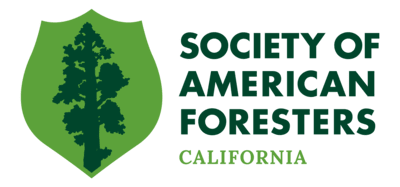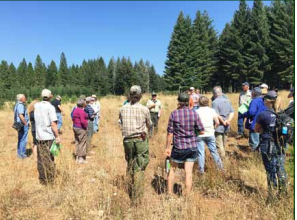
photo by Bill Snyder
The 2015 summer meeting was held in Auburn, California, and hosted by the Sac-Tahoe Chapter. As with past summer meetings, Friday evening was time for dinner and renewing acquaintances with fellow SAF members and spouses, with Saturday dedicated to a field trip on the Foresthill Divide. Following a productive joint NorCal-SoCal Executive Committee meeting and prior to the dinner meeting, Sierra Pacific Industries hosted a mill tour in Lincoln, California. This provided a unique opportunity to see a stateof-the-art sawmill, 18 Mw cogeneration plant, kilns and planning mill. Hosts Mark Luster and Grant Mitchell guided approximately 40 SAFers through a two-hour tour. We observed cedar logs being converted to boards, pine boards and lumber ready to be kiln dried, and white fir boards being planed, sorted and graded in preparation for shipping. This mill has been key to processing of firekilled timber from the King and Rim fires. A daunting task to say the least. We held the Friday evening dinner and silent auction at the Holiday Inn in Auburn, CA. We were privileged this year to have Matt Menashes, SAF CEO, brief dinner guests on key developments regarding SAF governance and provide an update on the sale of property adjacent to SAF national headquarters. We were pleased to also have Congressman Tom McClintock as a guest.

Congressman McClintock assisted Awards Committee Chair Julie Lydick with the presentation of John Mount’s 50-year Golden Member award. (Read the Golden Member awards story on pages 6 & 13.) The Congressman also discussed current legislation he has co-sponsored in the House of Representatives, which is designed to expedite post-fire salvage and restoration of National Forest system lands. Finally, dinner guests heard from Ph.D. candidate Philip Saska on the results of water shed research being conducted by the University of California, Merced. In addition, the silent auction and raffle raised over $1,500 for the Foresters’ Fund. Saturday morning nearly 75 participants loaded onto buses for the field trip up the Foresthill Divide to the Duncan Peak area and Robinson Meadow. The theme of this year’s field trip was water quantity and quality in relation to timber management.

photo by Bill Snyder
The Robinson Meadow stop included a welcome from Victor Lyon, District Ranger for the American River District. Philip Saska expanded on his dinner presentation with further explanation of developments in watershed research instrumentation and technology. The innovative research being conducted by UC Merced clearly holds promise for providing real-time data and watershed specific information that will ultimately lead to better predictions of water yields and timing of runoff. Susie Kocher, UC Extension Forester, followed Philip’s presentation with an update on the Sierra Nevada Adaptive Management Project (SNAMP) and findings relative to water provided. Susie also gave anoverview of the extensive cooperative public outreach effort that was part of SNAMP. Dave Bischel, CEO of the California Forestry Association, concluded the presentations at this stop with a summary of federal and state laws associated with water quality and the importance of good science with regards to making informed decisions. From Robinson Meadow, the group traveled to the Foresthill Forest Genetic Center for a picnic lunch and additional presentations on water and trees. Marie Davis, representing the Placer County Water District, provided insights into water quantity and quality from the water district’s perspective, particularly in relation to impacts of severe wildfires on soil, erosion and district operations. Salli Dymond provided a concise summary of key findings from Dr. Carolyn Hunsaker’s research in headwater streams of the Kings River Experimental Watersheds (KREW). KREW is designed to characterize headwater watershed attributes and understand the processes which effect the health of headwater watersheds, as well as evaluate the effect of forest restoration treatments focused on mechanical thinning and understory prescribed fire on headwater streams. Pete Cafferata, CAL FIRE hydrologist, wrapped up the discussions regarding forest management and water with an excellent synopsis of recent research, which provided an overview of wildfire-generated erosion, starting with a summary of how erosion impacts reservoirs in the Sierra Nevada. The field meeting concluded with two talks focused on trees. Dr. Jianwei Zhang gave a summary of the results for the recent re-measurements of plots established over 60 years ago. The plots were designed to test a range of stand densities relative to long-term stand development of planted ponderosa pine. Key conclusions of the latest measurements indicate that the potential for mortality in the stands could be managed and reduced through thinning and that without thinning, mortality can be predicted by stand density index. Even on high sites at a SDI of 230, bark mortality is rated as imminent, and at a SDI exceeding 365, heavy mortality is likely. The long term results relative to yields at different growing stock levels demonstrate that heavily thinned stands produced as much or more as lightly thinned stands.

Tom Blush, Regional Geneticist for the Southwest Region concluded the day with a briefing and walk through an Assisted Migration Adaptation Trial (AMAT) plot which was installed at the Genetics Center at the request of and in cooperation with the British Columbia Forest Service. The AMAT is designed to better understand growth and health of trees from British Columbia seed sources when planted across a range of latitudes and climates. While the first measurements of the plot have not been made, it was clear that there were more winners than losers with regard to survival and growth of the BC species. A great day in the woods.

